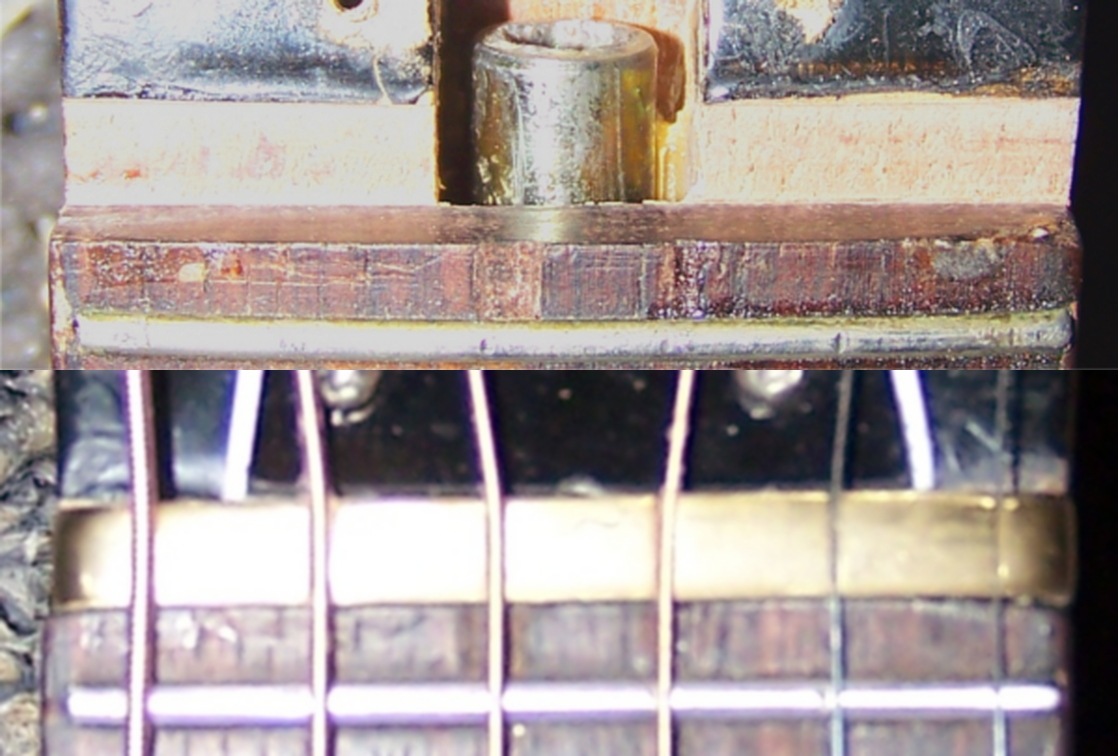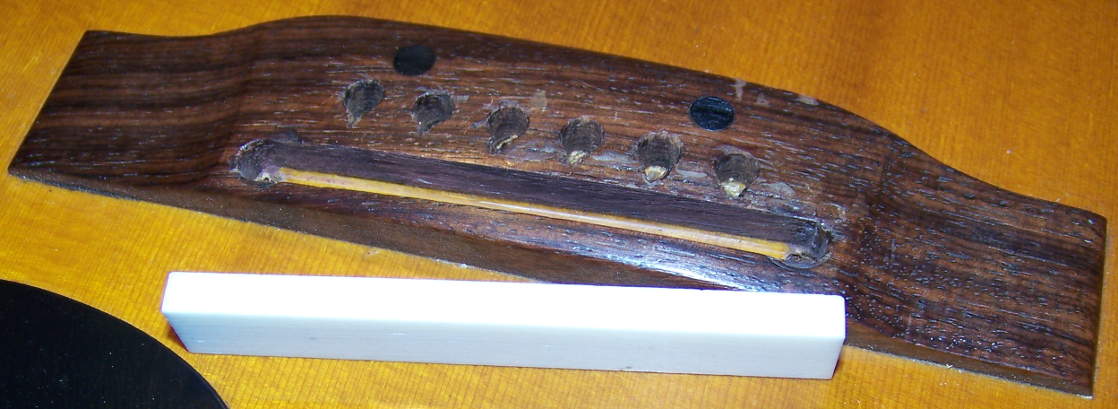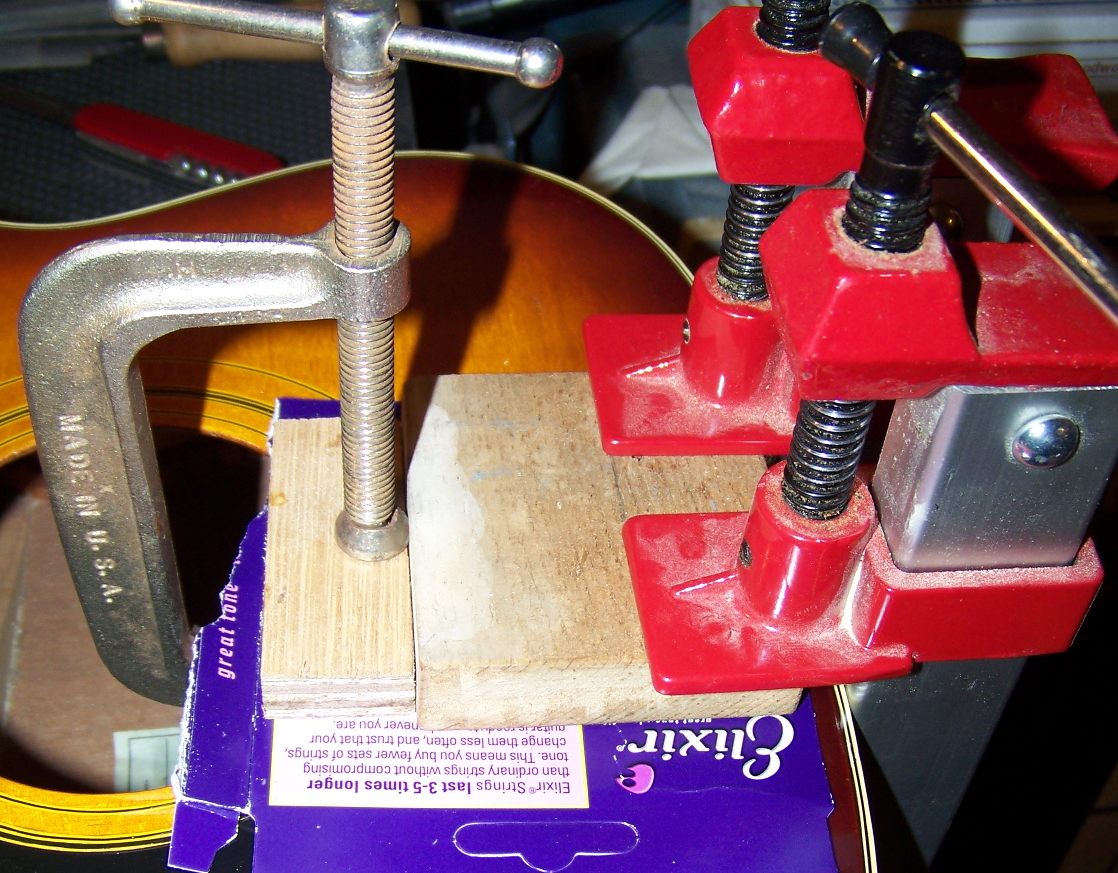 New nut:
New nut:
With all the frets free of indentations, I squared off the nut joint, and made a brass nut. Sorry for the blurry picture of the finished nut, it's nuts!

 A problem shows up:
A problem shows up:
I get out a piece of bear bone, and get ready to fashion a new saddle for this instrument:

I shape the saddle down to fit into the slot in the bridge, and put the strings on the instrument. With the strings on, I will be able to see how far the saddle needs to come down, and will also need the strings on to compensate it for intonation. As I tune up the instrument a big problem shows up: As I try and raise the pitch, the action increases enormously! I have to admit I was somewhat perplexed for the moment, because the neck was not rubbery in the leveling process, and I had checked the braces for integrity, before I got started. So I loosened the tension of the strings, and as I did so I could see that the top was not glued to the block of wood that housed the neck joint, and the neck joint was flexing something fierce!
The top had to be glued back down onto that block, and this poses a challenge, because if there was hide glue in there, it had to come out first. If you heat up hide glue it has a distinct smell to it, so I decided to scrape out a sample, and hold a lighter to it, but I could not find any glue! Well that may explain it! Looks like someone took a day off from work even though clocked in! I found some glue squeeze out at one of the braces and found it to be plain old yellow wood glue. That just made my work easier, as if there ever was any in there, it could stay there and would not react to the epoxy I was about to inject.
I wanted to avoid opening up a can of worms and removing the top around the neck joint binding and all, messing up the finish, and costing my client an added hundred dollars or more to sand it out before gluing and then putting it all back together and looking good, finish and all, so injecting epoxy that will stick to anything, dirt and all was the way to go. I mocked up my clamping setup, took it apart, injected the glue with a syringe, and clamped it together:

 Making the saddle:
Making the saddle:
With the neck joint shored up and the top glued down tight, the flexing is gone, and I can put my attention back at making a saddle. This is the final step where it all comes together, and as always where I tweak the instrument to its top performance.
I carve the saddle to exact height and compensation for each string, and also have to readjust the truss rod ever so slightly to arrive at a great action. Here is the saddle all done, and as usual because my camera shows little to no contrast with white on white, the compensation is hard to see, but then again who cares whether you can see it, as long as you can hear it, which you can't. But my client can, and trust me it is spot on, unlike many guitars including many Gibson's and even Martin's are when they leave the factory. If you think a good sounding guitar is everything, try one that not only sounds good, but plays in tune all the way up the neck!

 All said and done:
All said and done:
With everything done, and the client informed that his instrument is whole again, the "what if" thoughts race through my head until pick up time is at hand. No matter what, the clients reaction is the final say after any job. On the other hand I can not guarantee results this good if I do not get the chance to do everything possible to make an instrument perform at peek, and I am at the mercy of tweaking an instrument to whatever works best with a less than perfect fret job or what not. The what if questions will always be there as long as some people can not see the value of what all goes into delivering results this good, I mean with an action this low on an acoustic, you should be kicked in the head if you think it could be any better:

Yngwie Malmsteen would be impressed, and you would have to go through great lengths to stop him playing and send him home. My client was too, and can now truly enjoy this instrument for years to come. Just in case he decides that he wants to play it much harder, and the action is too low for that, he is covered for a whopping 6 months, and I will gladly tweak it to his liking. You can take advantage of this great service too, unless you are satisfied with "same ole', same old".